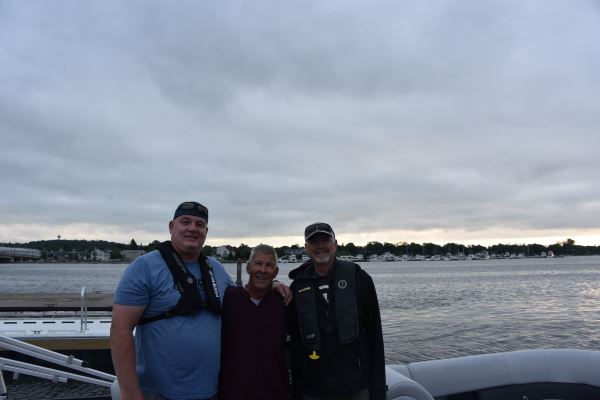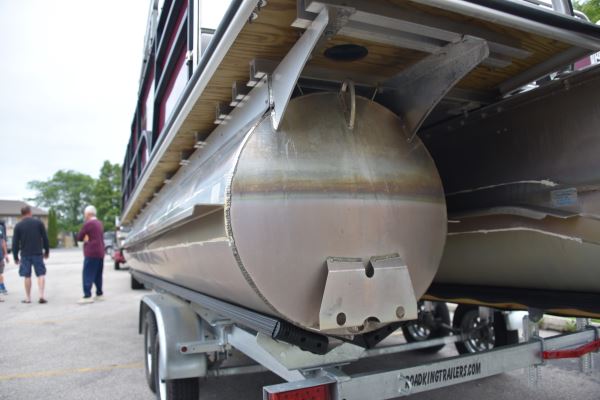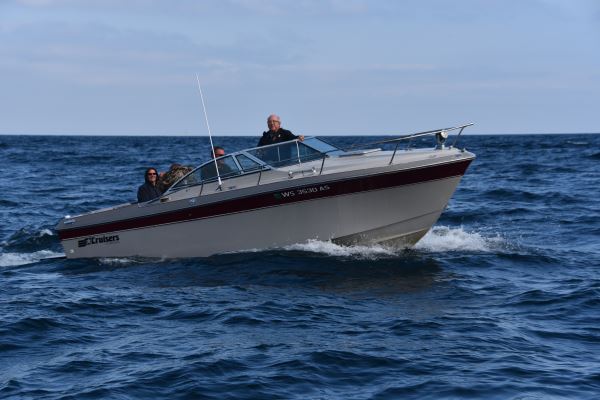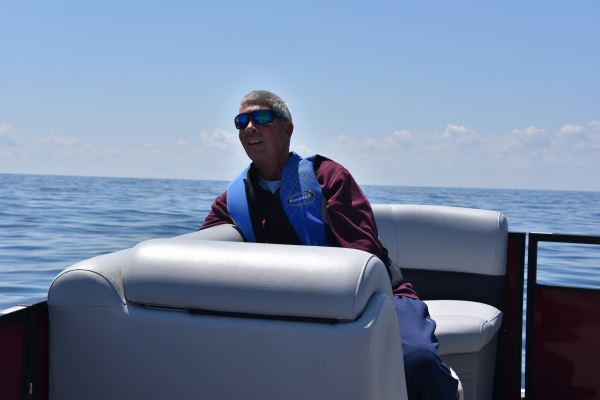Someday you may be invited on a nice pontoon cruise across the beautiful 22,000-square-mile Lake Michigan. If you get this opportunity to take a non-seafaring vessel across this ocean-like lake, let me urge you, with the greatest sincerity. Change your name. Fake your own death. Run for your life. Whatever you do, do not go. I know.
As part of his 25th anniversary from the first time he crossed Lake Michigan on a pontoon, Malcolm “Goofy” Sohm invited me to join him. His motivation was to recreate his first epic journey as part of his celebration of the trip that launched his invention of the Technically Advanced Performance (T.A.P.) Fin system and his Conrad Marine business. I’m not one to back down from an adventure, no matter how crazy or “goofy” it might sound, so I agreed to meet up with my friend in Wisconsin to document the adventure.
 Point Of No Return
Point Of No Return
We stayed the night in Sturgeon Bay, Wis., and at first light we launched Goofy's 22-foot Bentley Legacy 223 Navigator with a Mercury Pro XS 250hp outboard. Our “entourage” across Lake Michigan included a 23-foot Cruisers 220 Baron chase boat behind us in case of trouble, which also provided us with a little more peace of mind.
We left on a calm morning with high hopes of returning safely to this same marina after making a little stop in Frankfort, Mich.
“We're going to put in at Sturgeon Bay, go across to Frankfort, have breakfast, enjoy their company because they didn't believe us the first time we did this, and come back,” clarified Goofy as he detailed his plan. “At the end of the day we'll be able to say that pontoons can hold their own. Years ago we were laughed at, but it's not a laughing matter any more. Pontoons are the way to go.”
I guess at any point that morning we could have turned around, but after stepping foot on the pontoon that included portable gas cans, VHF radios and a few supplies, reality had sunk in and we were now fully committed to seeing this to the end. It is approximately 90 miles across one way, and we were ready.
The mid July air was a bit chilly that morning, but we were protected by land on each side of us to begin our run as we made our way through the Sturgeon Bay canal to where Lake Michigan opens up.
With big smiles on our faces we put down the throttle on the Mercury 250hp four-stroke as if we didn't have a care in the world. In truth I think everyone involved was a little nervous, especially Goofy's wife Terry who had stayed back after feeling a little sick leading up to the big day. Or maybe she was just the only one smart enough to fake an illness, we'll never know.
We rolled over those ocean-like waves like we were on a roller coaster as we conquered the massive and crestless waves. We yelled and cheered and that first hour was a great rush. Unfortunately, the ride lasted much, much longer.
 The T.A.P Fin Beginning
The T.A.P Fin Beginning
Back in 1999 using his shop-built pontoon, Goofy was out to prove his newly-invented T.A.P. Fins could increase the performance of any pontoon, while offering more stability and a smoother ride. What better place to prove that on a huge body of water such as Lake Michigan that few pontoon boats dare cross.
“I knew pontoons were going to be the family thing and the current pontoons at that time didn't deliver what the family needed. I was just ahead of the game,” recalled Goofy. “I decided to build a pontoon since I had my own body shop and had enough friends in the industry who knew a lot about the marine business who guided me. My daughter was in a wheelchair at that time and about to die and she couldn't go out with her dad because it was too rough. From my body shop experience I created these Fins that catch the negative energy and cushion the impact of the ride. We were able to enjoy boating together until she passed away.”
T.A.P. Fins are made of aluminum and mount about a quarter-inch out from your pontoon logs. Most pontoons come equipped with a small fin seated in the front of the boat, but these fins rarely handle water conditions well enough to create smoothness through the water. Not only that, but Goofy likes to point out that his competitor’s fins sit below the water line, rendering them ineffective and creating more drag, while T.A.P. Fins sit above the waterline, which leads to better performance, removing drag from the equation.
Conrad Marine’s website more clearly explains the design and advantages of T.A.P. Fins, but another benefit of being above the water is they are easier to clean. Because they have no small cavities to worry about after a day on the water, there is no chance of buildup inside. According to the inventor, fins under the water are more likely to grow bacteria and algae that also can create drag and be annoying to clean.
How They Work
T.A.P. Fins can be fitted on all pontoons, even three log boats or U-shaped tubes. The design traps the water from the sides and flips it downward to create a more positive lift.
“Look at any pontoon boat on a brochure or their website and you’ll see the picture is captured in motion and from the side,” explained Goofy. “You’ll also see a huge force of energy flying off the sides of the pontoon. What my Fins do is capture that energy and apply it downward, which in turns lifts the pontoon up and creates greater stability and a tighter turn radius with the ability to turn smooth with no hard leans.
 Isolation
Isolation
We soon reached that point across this massive body of water where you can look around in every direction and not see a speck of land and in our case, not another vessel besides our 23-foot chase boat. This is when reality began to sink in.
In the middle of Lake Michigan we didn't have any cell phone service so we couldn't help but feel a little isolated from the rest of the world. Of course, the waves were more intense too. It was like being on the roller coaster at Six Flags, only without rails. We got tossed around like a boat full of Gilligans as the `toon would dive, rise and then dive again, sometimes without much notice. Again, we didn’t see many boats out on the water that entire day and it’s easy to look back now and see why. The Bentley and the T.A.P. Fins did their jobs and it held up just fine in rough waves that served up 8-foot plus rollers at times. I, however, didn’t do as well. It was all I could do to not get a second look at the pizza I had eaten the night before...as well as the lunch before that. However, despite the rollers and the continued rocking motion, our crew kept it together.
 Gas Stop
Gas Stop
It felt like an eternity, but in reality the trip across took around four hours for us to safely reach Frankfort. Ironically it was the 23-foot fiberglass chase boat that struggled to keep up with the pontoon as they had to throttle back because of concerns the hull was taking too much of a pounding on those rough waves.
Now at the halfway point of our day, we were able to make some fuel comparisons. The original trip in 1999 with Goofy's 26-foot pontoon and a 200hp two-stroke Mercury engine drank 84 gallons of fuel to reach the same marina on the same route 25 years earlier. This time around – to everyone's amazement – the Pro XS Mercury 250hp four-stroke sipped less than 25 gallons.
“This isn't your grandpa's boat, but grandpa would be proud of it,” said Goofy. “Grandpa would be real proud of it.”
We made small talk with the fuel guy at the marina who was a little shocked that we had really come from Wisconsin that morning...on a pontoon. He had watched two 50-foot boats leave the marina with plans to head to Mackinac, but both had turned around and come back because the boat owners felt it was too rough.
Heading Back
We took a few minutes to stretch our legs, sip on some water and get mentally prepared to recross. No one in the group felt like eating much, and just seemed anxious to get back to Wisconsin in case the wind picked up. Heading across gave me a new appreciation of what my socks must feel like when they're in the washing machine. Our conversations on the pontoon were limited, not necessarily because of the wind noise, but because we were more focused on enduring the constant and unpredictable rocking motion than chatting. We were predicting a similar ride back, yet the return trip to Wisconsin was much smoother by comparison as we were able to push our speed up to 25mph. In fact, despite a GPS miscalculation that led us 30 miles off course, we made it back to our starting marina in about 3.5 hours. Other than maybe watching two Super Bowls back-to-back or the entire [Lord of the Rings] trilogy, what else would you rather do with an 8-hour day?
.JPG_600.jpg) Another Goofy Adventure
Another Goofy Adventure
After getting the boat out of the water and reuniting with his relieved wife, the very tired and exhausted boat owner smiled and said to his wife, “We did it!”
As for my own wife, I felt it was best to let her know that I was going on this trip...after I had completed it.
The recreation of his first trip across Lake Michigan exceeded his expectations and proved once again that with Goofy's aftermarket T.A.P. Fins, anything is possible. It was also a good reminder that as a general rule, pontoon boats are best suited for smaller lakes and not necessarily for the ocean or ocean-like lakes. However, it is nice to know that this one was built strong enough to survive a trip across one of the Great Lakes. But remember, if anyone ever calls you up and invites you to take a leisurely pontoon cruise across Lake Michigan, move to Guam.

